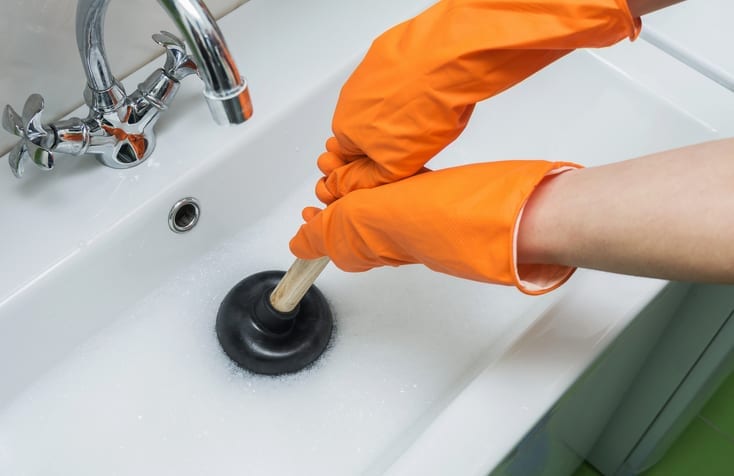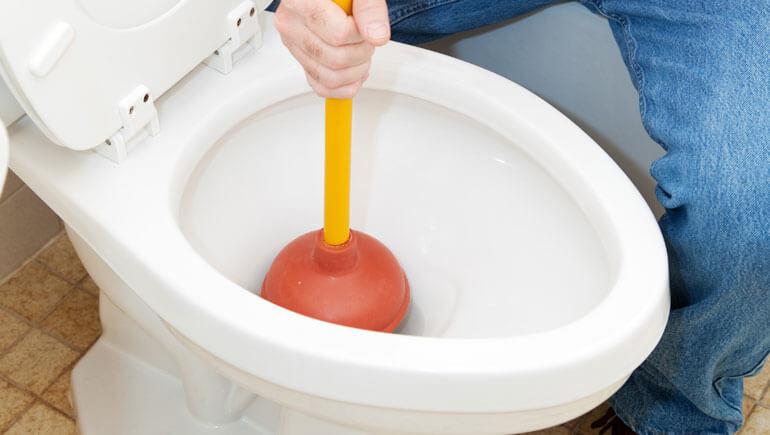Improving Plungers and Drain Cleaner: Professional Techniques
Improving Plungers and Drain Cleaner: Professional Techniques
Blog Article
On this page down the page you can find lots of good points in relation to How To Use Your Toilet Plunger Correctly in 5 Easy Steps.

Introduction
Correct maintenance of family drains is necessary for preventing blockages and making certain smooth water flow. One of the secret devices in every home owner's toolkit is the plunger, alongside numerous drain cleaners developed to tackle persistent clogs properly. This short article discovers how to make use of plungers and drainpipe cleansers properly to keep your drains streaming easily.
Area 1: Recognizing Plungers
Sorts of Plungers
There are several types of plungers available, each made for various sorts of drains and clogs. The most common kinds consist of mug plungers, flange bettors, and accordion bettors.
How Plungers Work
Bettors service the principle of developing stress and suction to remove obstructions. When appropriately applied over a drainpipe, they produce a vacuum cleaner that can take out particles or separate clogs.
Choosing the Right Plunger
Picking the best bettor depends upon the sort of drainpipe and the nature of the clog. Cup bettors are perfect for sinks and tubs, while flange plungers are much better suited for commodes as a result of their style.
Typical Mistakes with Bettors
Preventing these mistakes ensures effective plunging: inappropriate seal around the drainpipe, not enough pressure, and unclear bordering debris.
Section 2: Utilizing Plungers Efficiently
Prep work
Before diving, guarantee the bettor covers the drainpipe completely and develops a limited seal. Clear any type of visible particles around the drain opening.
Method
Beginning with gentle diving activities to construct suction. Rise pressure progressively, making use of a steady rhythm. Repeat as necessary up until the drainpipe gets rid of.
Fixing Tips
If diving does not work, attempt adjusting the seal, using petroleum jelly for a better seal, or using a various sort of bettor.
Section 3: Understanding Drainpipe Cleansers
Types of Drainpipe Cleaning Company
Drain cleaners can be chemical or chemical. Chemical cleaners utilize strong chemicals to dissolve obstructions, while enzymatic cleansers utilize all-natural enzymes to break down organic matter.
Just How Drain Cleaning Company Job
Chemical cleansers respond with blockages to liquify them, while enzymatic cleansers break down natural materials like hair and grease without hurting pipelines.
Safety and security Considerations
Always put on handwear covers and eye security when using chemical drain cleansers. Guarantee appropriate ventilation and adhere to producer guidelines meticulously.
Eco-Friendly Alternatives
Think about using vinegar and cooking soda or enzyme-based cleansers for environmentally friendly alternatives that are much safer for pipes and the atmosphere.
Area 4: Using Drainpipe Cleaners Efficiently
Application Techniques
Pour chemical cleaners straight into the drain opening. Permit them to benefit the suggested time before flushing with hot water. Chemical cleansers must rest overnight.
Safety measures
Avoid mixing various sorts of cleaners, as this can produce hazardous fumes. Never ever use chemical cleaners combined with a plunger, as splashing can occur.
Dealing With Persistent Blockages
For consistent blockages, think about utilizing a plumbing snake or calling a professional plumbing to avoid damage to pipelines.
Verdict
To conclude, comprehending just how to use plungers and drainpipe cleansers effectively is vital for keeping healthy and balanced pipes systems. By choosing the right devices and techniques, home owners can tackle minor obstructions and prevent significant pipes problems down the line.
How To Properly Use A Plumbing Snake To Clear Drains
When any drain clogs in our home arise, we tend to gravitate toward the plunger and little else. In cases where the plunger and its vacuum-created pressure are not able to clear clogs, many immediately move to harmful chemicals or simply call their plumber to fix the issue.
we’re happy to help with all drain cleaning needs and concerns. This includes informing you on a few other home remedies you may have at your disposal for minor to moderate clogs, one of which is the use of a plumbing snake. Many people have never used one of these before – let’s go over the steps to take when your drain clogs and you have a plumbing snake available.
Attempt Plunger Use
The first step here, as we noted above, should indeed be to grab your plunger when you notice a drain clog and attempt to resolve it this way. If you’re unsure how to use a particular type of plunger, our plumbers can answer any questions you have. If this doesn’t do the trick, however, you move on to the snake.
Locate And Prepare Snake
A plumbing snake is a metal or plastic device that’s generally about a quarter of an inch thick. It’s design with significant extensions, meant to reach down into your clogged drain and push the clog out. Snakes also contain drain augers that will latch onto and push stubborn blockages.
If your plunger doesn’t clear a clog, locate your snake and bring it to the drain in question. We also recommend keeping a bucket nearby to collect the clog once you pull it out, plus we’d advise wearing goggles and possibly protective gloves.
Feed Snake
Once you’re ready to go, feed the snake slowly down the drain, using the crank device it comes with to keep it moving until it finds the clog. Once this happens, much of the clog will be latched onto the coil so you can pull it out, while the rest will simply break up and flow downward.
Detach Debris
Remove the snake slowly from the drain, and once you’ve done so, pick off any debris that’s stuck to the coil. This is another area where wearing gloves is a must.
Flush Drain
Finally, take a few minutes to ensure the snake has done its job correctly. If you’ve been using it on a toilet, flush the toilet a couple times and make sure everything flows well. If you’ve used it on a different drain, flush it with some room temperature water.
https://www.mybuddytheplumber.com/blog/how-to-properly-use-a-plumbing-snake-to-clear-drains/

Application Techniques
Pour chemical cleaners straight into the drain opening. Permit them to benefit the suggested time before flushing with hot water. Chemical cleansers must rest overnight.
Safety measures
Avoid mixing various sorts of cleaners, as this can produce hazardous fumes. Never ever use chemical cleaners combined with a plunger, as splashing can occur.
Dealing With Persistent Blockages
For consistent blockages, think about utilizing a plumbing snake or calling a professional plumbing to avoid damage to pipelines.
Verdict
To conclude, comprehending just how to use plungers and drainpipe cleansers effectively is vital for keeping healthy and balanced pipes systems. By choosing the right devices and techniques, home owners can tackle minor obstructions and prevent significant pipes problems down the line.
How To Properly Use A Plumbing Snake To Clear Drains
When any drain clogs in our home arise, we tend to gravitate toward the plunger and little else. In cases where the plunger and its vacuum-created pressure are not able to clear clogs, many immediately move to harmful chemicals or simply call their plumber to fix the issue.
we’re happy to help with all drain cleaning needs and concerns. This includes informing you on a few other home remedies you may have at your disposal for minor to moderate clogs, one of which is the use of a plumbing snake. Many people have never used one of these before – let’s go over the steps to take when your drain clogs and you have a plumbing snake available.
Attempt Plunger Use
The first step here, as we noted above, should indeed be to grab your plunger when you notice a drain clog and attempt to resolve it this way. If you’re unsure how to use a particular type of plunger, our plumbers can answer any questions you have. If this doesn’t do the trick, however, you move on to the snake.
Locate And Prepare Snake
A plumbing snake is a metal or plastic device that’s generally about a quarter of an inch thick. It’s design with significant extensions, meant to reach down into your clogged drain and push the clog out. Snakes also contain drain augers that will latch onto and push stubborn blockages.
If your plunger doesn’t clear a clog, locate your snake and bring it to the drain in question. We also recommend keeping a bucket nearby to collect the clog once you pull it out, plus we’d advise wearing goggles and possibly protective gloves.
Feed Snake
Once you’re ready to go, feed the snake slowly down the drain, using the crank device it comes with to keep it moving until it finds the clog. Once this happens, much of the clog will be latched onto the coil so you can pull it out, while the rest will simply break up and flow downward.
Detach Debris
Remove the snake slowly from the drain, and once you’ve done so, pick off any debris that’s stuck to the coil. This is another area where wearing gloves is a must.
Flush Drain
Finally, take a few minutes to ensure the snake has done its job correctly. If you’ve been using it on a toilet, flush the toilet a couple times and make sure everything flows well. If you’ve used it on a different drain, flush it with some room temperature water.
https://www.mybuddytheplumber.com/blog/how-to-properly-use-a-plumbing-snake-to-clear-drains/

I found that piece of writing about How to Use a Plunger to Unclog a Toilet or Drain while perusing the internet. In case you enjoyed our blog entry please don't forget to share it. I am grateful for your time. Return soon.
Click Here To Read More Report this page